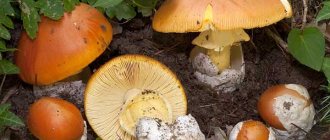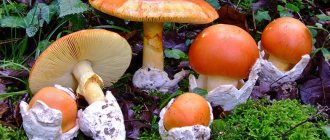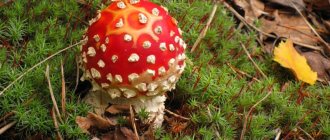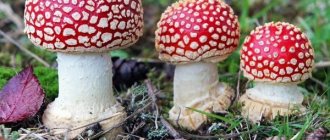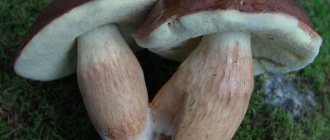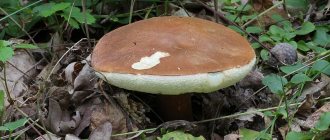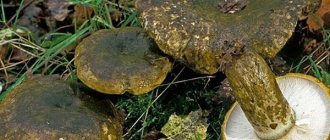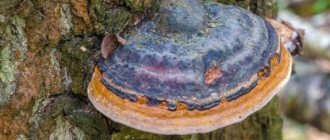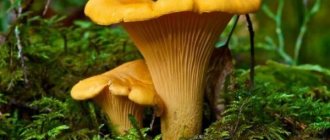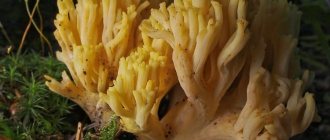Caesar's mushroom also goes by names - Caesar's fly agaric, Caesar's mushroom or Caesar's mushroom (lat. Amanita caesarea). It grows over vast areas and is found in the forests of many countries in Europe, Asia and North America. Popularly, this species is often called the Egg Mushroom, due to the fact that at the very beginning of its development the fruiting body is covered with an egg-shaped cocoon. It has found application in many areas, including folk medicine. Caesar mushroom is used to prepare an independent dish and as a dietary supplement.
A photo of Caesar mushroom and a description of how this species can be prepared so that it does not lose its beneficial qualities are presented below.
Description of the appearance of the mushroom
Those who saw the Caesar mushroom for the first time are truly surprised by its unusual appearance, or rather even the way it grows.
Fruiting body
The mushroom has a fairly bright color, which ranges from orange to brick color. The cap of a young mushroom is ovoid or dome-shaped and gradually, as it grows, flattens to form a velvety edge.
The upper plane of the cap is quite clean and smooth, sometimes even forming a glossy surface. Inside the cap the flesh is yellowish in color and the consistency is quite juicy. The diameter can vary from 8 to 20 cm.
Stipe
The Caesar mushroom has a thin stalk compared to the cap. In addition, it is long enough to lift the mushroom high above the ground.
It can reach a maximum length of 12-14 cm. With a diameter of only 2-3 cm. A distinctive feature is the tuberous base and blanket, which forms a specific cocoon.
The so-called blanket is the annular part of the mushroom stem, which has the shape of a fairly deep and wide groove. The fly agaric has a similar structure.
If we talk about the cover of the Caesarean mushroom, then its thickness is about 4 mm, and its height can reach up to 6 cm.
Cesarean mushroom spore powder
The powder, which is formed from fungal spores, is white.
Medicinal properties
The benefits and harms of this mushroom have already been well studied. Since this mushroom does not contain toxic substances, it cannot cause signs of poisoning or other adverse effects. Using this variety for food can bring great benefits to the human body. This product is low calorie. 100 g of product contains no more than 19 kcal. In addition, the pulp contains small amounts of carbohydrates and fats. This product is high in protein. The active acids present in the mushroom pulp include:
- ascorbic acid;
- alpha-ketoglutaric;
- apple;
- fumaric;
- lemon;
- amber.
This fruiting body contains a high content of vitamins B, A, PP and D. In addition, the pulp is an important source of selenium, potassium, sodium, manganese, iron and some other elements. From edible fly agarics grown under artificial conditions, scientists isolate ergosterol, which is later used to obtain the vitamin. In addition, it was found that the fruit body contains a compound that has an inhibitory effect on staphylococcus and Bacillus subtilis.
These mushrooms contain many vitamins
Traditional healers use an extract of this mushroom to treat cancer. In addition, it is believed that regular consumption of edible fly agaric mushrooms reduces the risk of developing malignant tumors. In some regions, a tincture of this mushroom is used to rub joints for diseases such as rheumatism, arthrosis and gout. Regular inclusion of the royal fly agaric in the diet helps eliminate atherosclerosis.
Mushroom propagation
The fungus can develop normally only in well-lit areas. Fruits most intensively on the southern slopes of forest edges or mountains.
For the active development of the mycelium, it needs good, warm weather without sudden changes.
For almost a month there should be weather with temperatures not falling below 20 degrees Celsius.
Nutritional value of Caesar mushroom
Amanita Caesar or the king's mushroom is considered one of the delicacies in the world of mushrooms. Moreover, the nutritional value was discovered in ancient Rome and ancient Greece. In ancient Rome it was called “bolete” and was considered the most important mushroom. This type of mushroom was especially valued during the time of the commander Lucullus. And throughout the centuries, it was one of the main delicacies that could amaze guests.
Edibility and restrictions on consumption
Caesar mushroom is edible, has excellent taste and is considered a delicacy. Green mushrooms can be dried, fried and baked over an open fire. The youngest specimens, which are still covered with unbroken volva, are added raw to salads.
Contraindications to eating this variety are:
- childhood;
- individual intolerance;
- urolithiasis disease;
- gout;
- problems with the gastrointestinal tract.
How not to confuse it with the common fly agaric?
To avoid any doubts whether this is a red fly agaric or Caesar's fly agaric, you should take a closer look at the following signs:
- Caesar mushroom has a smooth cap without white spots. True, sometimes minor scales from the bedspread may remain on it.
- The color of the leg is yellowish, while that of the fly agaric is exclusively white.
- His bedspread has a wide edge, which is sometimes torn. While the fly agaric has a bed with ring-shaped remains only at the base of the stalk.
In order to more thoroughly imagine the difference between the two mushrooms, it is worth looking at a photo of the Caesar mushroom and then comparing them with the fly agaric.
Where to look
The growing area of the Caesar mushroom is located in many countries with different climatic conditions. It can be found both in the deciduous forests of Crimea and Transcarpathia, and in some places in Africa. Also, Caesar mushroom is not uncommon in America and the Caucasus. In Europe it has spread to Italy, Spain, France and Germany. The Caesar mushroom mainly grows in areas with temperate climates.
Due to its various beneficial properties, Caesar mushroom is listed in the Red Book of Germany and Ukraine.
